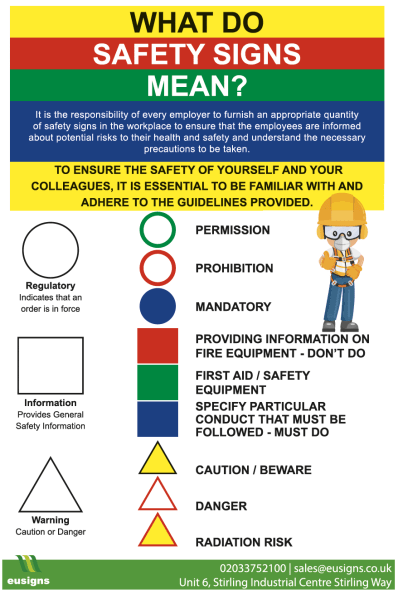Health and Safety Sign Colours: Understanding the Meanings Behind Them
In the UK, health and safety signs are a crucial part of keeping workers and the public safe from potential hazards. These signs are required in workplaces and public areas to warn people of potential dangers and provide information on how to stay safe. But did you know that the colours of these signs have specific meanings? Understanding the meanings behind health and safety sign colours can help you better interpret these signs and stay safe in your environment. In this article, we’ll take a closer look at the different colours of health and safety signs and their meanings.

Download and Print. Free “Safety signs What do they mean?” Poster
Red Signs
Red signs are used to indicate that immediate action is required. This colour is used for prohibition signs, such as “No Smoking” or “No Entry“, which indicate that a certain behaviour is not allowed in a particular area. Red is also used for fire-related signs, such as “Fire Exit” or “Fire Alarm,” which indicate the location of fire-related equipment and emergency exits. When you see a red sign, you should take immediate action to comply with the instructions or evacuate the area in case of emergency.
Yellow Signs Yellow signs are used to indicate caution or warning. This colour is used for hazard signs, such as “Danger – High Voltage” or “Caution – Wet Floor,” which indicate potential hazards in the area. Yellow signs can also be used to indicate that personal protective equipment (PPE) must be worn, such as “Wear Safety Glasses” or “Wear Protective Gloves“. When you see a yellow sign, you should exercise caution and take the necessary precautions to protect yourself from potential hazards.
Blue Signs Blue signs are used to indicate mandatory instructions. This colour is used for signs that indicate specific actions that must be taken, such as “Wear Ear Protection” or “Use Handrail.” Blue signs can also be used to indicate the location of specific equipment, such as “Emergency Shower” or “First Aid Station.” When you see a blue sign, you must follow the instructions provided.
Green Signs
Green signs are used to indicate that something is safe or that a particular action is permitted. This colour is used for signs such as “Emergency Exit,” “First Aid,” or “Escape Route,” which indicate safe routes and locations in case of emergency. Green signs can also be used to indicate the location of safety equipment, such as “Safety Shower” or “Eye Wash Station.” When you see a green sign, you can be assured that the action or location is safe and permitted.
Orange Signs
Orange signs are used to indicate potential dangers or hazards that are associated with machinery or equipment. This colour is used for signs such as “Danger – Forklift Trucks,” which indicate that particular machinery or equipment is in use in the area. Orange signs can also be used to indicate that a particular area is a construction site or that certain safety procedures must be followed when working in the area. When you see an orange sign, you should take the necessary precautions to protect yourself from potential hazards associated with machinery or equipment.

Health and safety sign colour guide
In conclusion, health and safety signs are a critical part of keeping workers and the public safe from potential hazards. Understanding the meanings behind health and safety sign colours can help you better interpret these signs and stay safe in your environment. Red signs indicate that immediate action is required, yellow signs indicate caution or warning, blue signs indicate mandatory instructions, green signs indicate that something is safe or permitted, and orange signs indicate potential dangers or hazards associated with machinery or equipment. Be sure to familiarise yourself with the different colours of health and safety signs to stay safe in your environment.
Headlines from our safety sign blog:
- Are Safety Signs Mandatory in the UK Workplace?
- A closer look to the six safety colours
- 5 Types of Safety Signs
- Categories of Fire Signage






